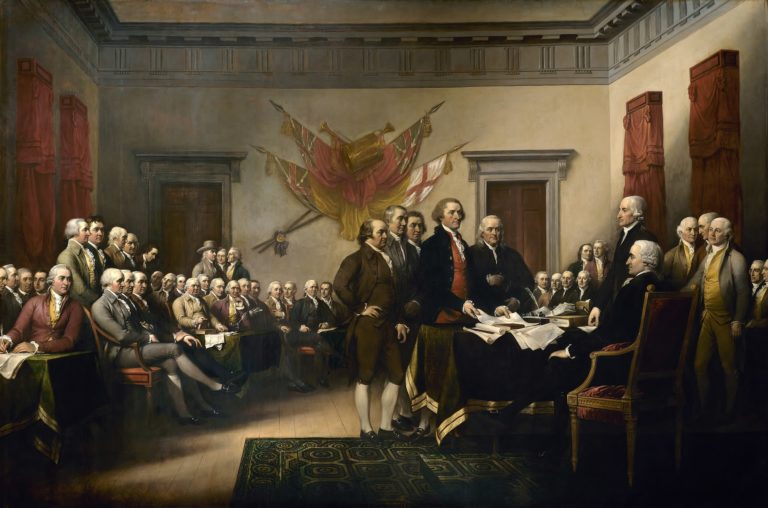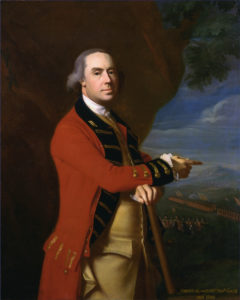Art, Violence, and the American Revolution

Violence is the business of war—sword, gun, and canon wreaked havoc among soldiers, sailors, militiamen, and civilians as they faced off in deadly confrontation during the Revolution. Violence against individuals expressed outrage, retaliation, and political conviction. Violence, in those years of Revolution, in this conflict born of an Enlightenment political science experiment, also was visited on art objects, proxies for hated men and even more hated policies.
Thomas Hutchinson’s mansion, for instance, on August 26, 1765, was assaulted by an angry Boston mob, its Georgian elegance ransacked during the Stamp Act Crisis. Historians may not weep for the mahogany furniture, but they have mourned the archive of seventeenth- and eighteenth-century documents scattered to the winds that dark night (fig. 1). Similarly, in the heated riots of 1769, a mob entered Harvard Hall and cut the “heart” from the Copley portrait of Governor Francis Bernard hanging there. Another vandalized Copley portrait was of Joshua Henshaw, “an able man, a firm ‘Son of Liberty,’ who, [when British soldiers sent to Boston to restore order in 1768 were billeted on the populace] left nothing undone which would make the condition of the soldiers uncomfortable.” His likeness was reportedly slashed by a British bayonet when war erupted and Henshaw removed his household in haste, leaving his furnishings in Boston (fig. 2). More dramatically, a larger-than-life-size 4,000-pound equestrian statue of King George III—cast of lead and gilt with sheets of gold—that had been erected in 1770 in New York City was pulled down on July 9, 1776, by a mob and fashioned into bullets, projectiles flung at the king’s troops in succeeding months.
Patrick Spero prompts Margaretta Lovell to talk about historical memory and material culture.
The problem of war, of course, is that even when passions are not inflamed by specific policies, symbolic executions, betrayals, and cruelties, it shatters the very thing it seeks to establish or reestablish—everyday life lived in peace and prosperity. Everyday life—especially among the craftsmen who have been the focus of my interest during this period—was the universal collateral damage of the war. During the Revolution, coastal, Caribbean, and transatlantic trade was disrupted or halted altogether; materials for the fabrication and production of all kinds of goods were unobtainable; many markets were shut down, and whole sectors of the production economy faltered. Furniture craftsmen whose skills in design and fabrication were such that their works now sell for more than McMansions eked out a living repairing chicken coops. They lost their markets, their suppliers, their patrons, and their customers, even when they did not lose their shops, their kin, or their lives.
What did artists do under these circumstances? How did the trade in face-painting do? The Pennsylvanian (and lapsed Quaker) Benjamin West, having emigrated years earlier but maintaining his American identity, spent the Revolution in London. Indeed, in 1772 he was appointed historical painter to the court with an annuity from the king and a studio in the palace. Gilbert Stuart spent the Revolution in London in West’s studio, maturing into a successful portraitist of the British elite. Essentially, then, these artists stayed out of the fray, while quietly “voting with their feet.”
John Singleton Copley, located at the eye of the storm in Boston, equally asserted the apolitical nature of the artist, voicing neither Loyalist nor Patriot affiliations. As tempers flared in the years leading up to the Revolution, he proved himself an equal opportunity painter: the commander in chief of British forces, General Gage, sat to him, as did arch-Patriots Sam Adams and Paul Revere (figs. 3, 4). Copley’s stance of high-minded neutrality, however, was taxed when his father-in-law’s tea was thrown into Boston Harbor; he found this a convenient time to go to Italy to study European art.
John Trumbull, youngest of these Revolutionary-era artists, enlisted and became aide-de-camp to George Washington, but resigned in 1777, traveling to England in 1780 to study in the studio of Benjamin West. The British did not view his apolitical art project in exactly the same light as he did, and threw him in jail as an enemy combatant. But my point is that in 1780 Trumbull went to London to study art!


Charles Willson Peale is the unambivalent exception to the apolitical (or somewhat Loyalist) stance of most colonial painters. Having spent two years in West’s studio in the 1760s, he returned to America, and, in 1776, settled himself in Philadelphia. He enlisted in the Continental Army, saw action, and served in the Pennsylvania State Assembly, returning to painting and the study of natural history in 1780. Peale eventually assembled a gallery of all the principal faces of the Revolutionary movement (many of these portraits remain together and today are housed in the Second Bank of Pennsylvania, near the location of Peale’s original museum) (figs. 5, 6).

Excepting Peale, all the major American artists of the Revolutionary period appear to have placed art and personal ambition above politics and national feeling. Nevertheless, when we imagine the events and personages of the Revolution, we do so in images they have given us. Gilbert Stuart’s Athenaeum Washington is the iconic face of the Father of his Country, and we all keep the engraving in our wallets on the one-dollar bill (fig. 7). Stuart is said to have painted 130 reproductions of this unfinished original and called them, perhaps a little cynically, his “hundred-dollar bills.”

Trumbull’s Declaration of Independence, begun in 1785 in Paris, is the iconic rendering of that event and of the faces of those participating. The original is at Yale (Trumbull’s later large-scale copy is in the U.S. Capitol in Washington), and we are familiar with the image from the back of our two-dollar bill (fig. 8). His Battle of Bunker Hill (1786) is equally the best-known battle scene of the war. Abigail Adams, upon observing the work, commented that Trumbull “is the first painter who has undertaken to immortalize by his pencil those great actions that gave birth to our nation. He teaches mankind that it is … character alone, which interests posterity.” Character here is represented by both Patriot and English soldiers deflecting the bayonet of an unfeeling redcoat from the dying body of Gen. Joseph Warren (fig. 9).


My point is that artists seemed to float above (or outside) the fray, but they certainly made hay in the shadow of the Revolution fixing the public memory of the event and its cast of characters. I do not think artists were more ideologically confused or more economically disadvantaged than other craftsmen, although they certainly were in a more socially ambiguous position, rising from modest birth to intimacy with elites, aristocrats, and the king himself. Their chameleon loyalties were to art, and may well have had an element of Stockholm syndrome.


To return to the broader picture: What is the role of material culture in the study of serious history? I would say that the test of its utility for a historian (as distinct from its utility for a collector or curator) is that it provides material evidence that can teach us something significant on which the written record is silent, ambiguous, or obscure. What Peale and Stuart capture in their portraits of the Founding Fathers is not the intensity of their convictions, the violence of the conflict, the inflamed visual rhetoric of nation-building, nor the presumed passionate fire of leadership, but rather the precise physiognomy of the major players, their faces expressing extreme calm and insightful reason. Whether they correctly interpret the faces and behaviors of their subjects is immaterial; what is key is the social and political ideal these portraits embody of purely cerebral activity. What Trumbull intended in Bunker Hill, similarly, was to pantomime violence not as brute force, but as the site of character-formation and character-revelation: specifically, the heroic virtue of dying for one’s nation and the redemptive virtue of clemency. British and Patriot officers collaborate in deflecting the bayonet of a bull-headed grenadier so that all the parties (including the viewer) can savor the exemplary Dr. Warren’s moment of illumination: Dulce et decorum est pro patria mori. These are the stories the generation of the Revolution wanted to tell and to hear. That these tales do not move us—indeed, that they appear to operate as cover stories for vastly different motivations—does not subtract from the fact of their testimony concerning the power of those narratives in that distant period.
Further Reading:
For more on the visual culture that grew out of the era of the American Revolution, see Margaretta Lovell, Art in a Season of Revolution: Painters, Artisans, and Patrons in Early America (Philadelphia, 2005).
This article originally appeared in issue 14.3 (Spring, 2014).
Margaretta M. Lovell is the Jay D. McEvoy Jr. Professor of the History of Art at the University of California, Berkeley. Her books include Art in a Season of Revolution: Painters, Artisans, and Patrons in Early America (2005), winner of the Smithsonian’s Charles C. Eldredge prize.
